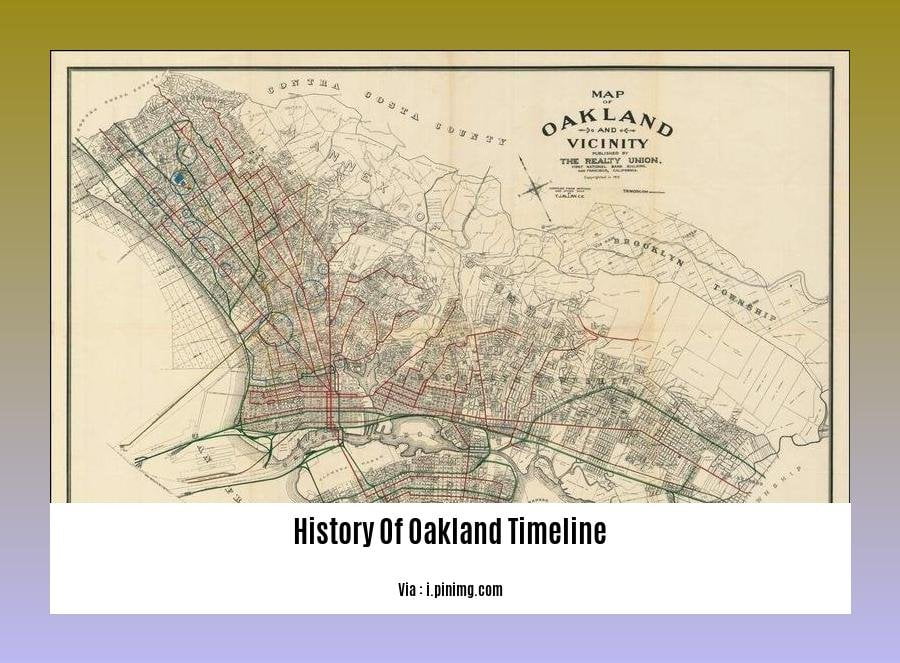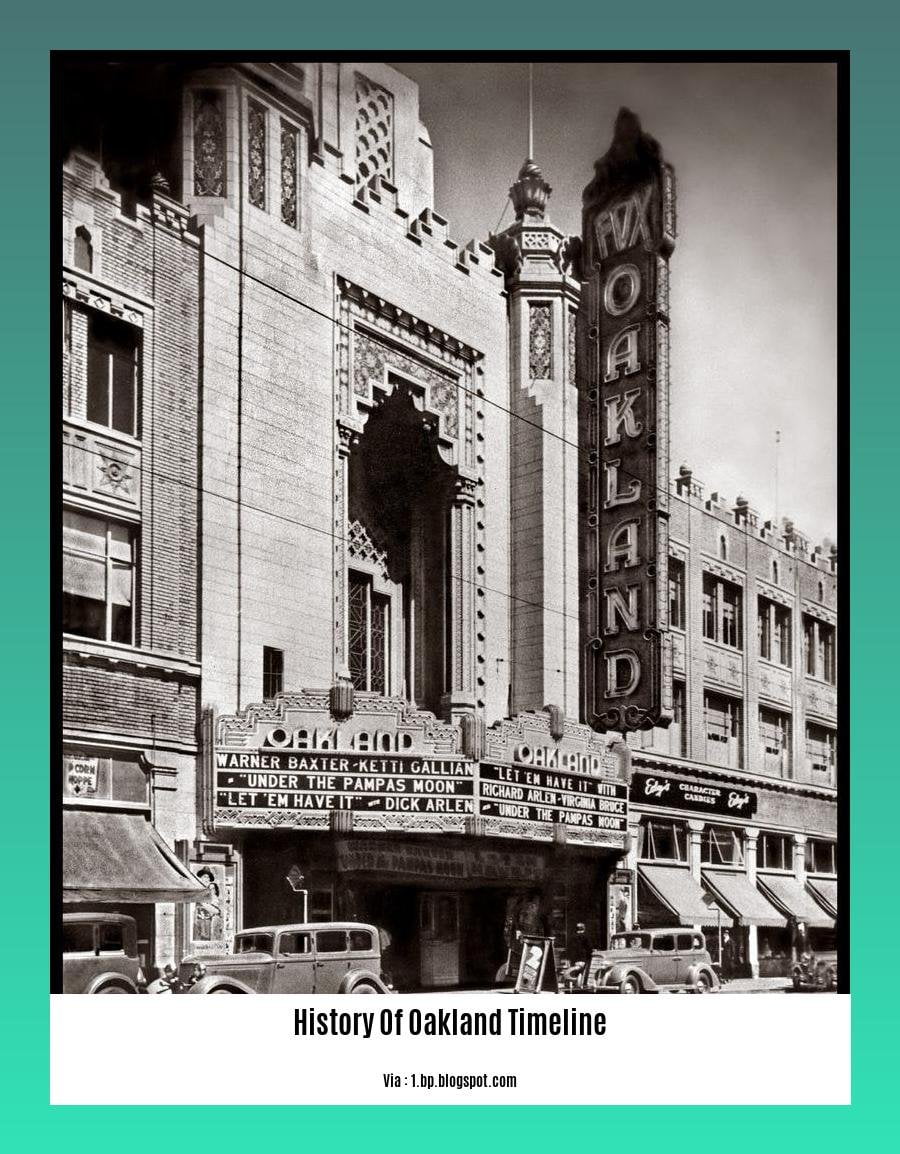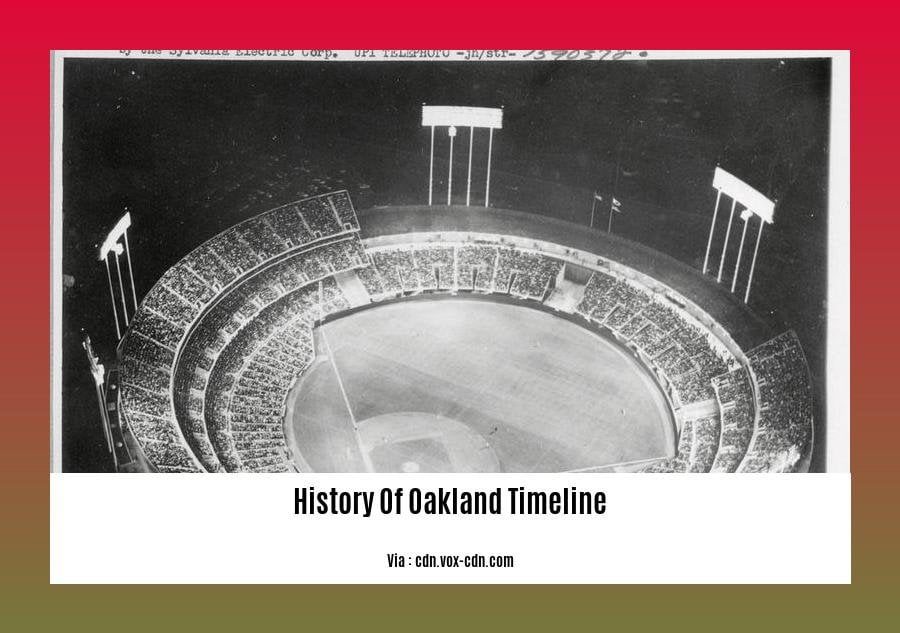Embark on a historical odyssey through the vibrant city of Oakland in [- Unraveling Oakland’s Past: A Comprehensive Timeline of Historical Milestones]. This captivating narrative transports readers to a bygone era, unveiling the pivotal moments that shaped Oakland’s identity. From the construction of Antonio Peralta’s home to Horace Carpentier’s appointment as the city’s first mayor, each milestone holds significance in Oakland’s rich tapestry. Moreover, the desegregation of Oakland schools stands as a testament to the city’s unwavering commitment to equality. Join us as we delve into the annals of time, exploring the events that have left an indelible mark on Oakland’s legacy.
Key Takeaways:
Oakland’s history can be traced to a settlement founded by Horace Carpentier, Edson Adams, and Andrew Moon in the 19th century.
The earliest inhabitants were the Huchiun tribe, part of the Ohlone people.
In 1772, Spanish conquistadors claimed Oakland and other Ohlone lands for Spain.
Oakland was incorporated as the City of Oakland in 1854, with Horace Carpentier as its first mayor.
Oakland experienced an economic boom in the 1920s, primarily due to industries like automobiles, construction, and film.
During World War II, the East Bay, including Oakland, was home to significant war-related industries, such as the Kaiser Shipyards in nearby Richmond.
History of Oakland Timeline: Tracing the Growth and Evolution of a Vibrant City


Oakland, a vibrant city with a rich tapestry of past and present, carries a compelling narrative of human settlement, cultural fusion, technological advancements, and social transformations. Its history of Oakland timeline is a journey through these remarkable milestones:
1820s: The Genesis of Oakland
The story of Oakland begins with the Huchiun tribe, the original inhabitants who called this land home long before colonization. The Spanish conquistadors arrived in 1772, claiming the region, including Oakland, for the Spanish crown.
1850s: A New Beginning, A City Rises
The city’s modern history takes root in the 1850s, marked by the arrival of Horace Carpentier, Edson Adams, and Andrew Moon, who founded a small settlement that would eventually transform into the thriving city of Oakland. The establishment of Oakland as a city in 1854, with Horace Carpentier as its first mayor, stands as a testament to the city’s burgeoning growth and aspirations.
1869: The Transcontinental Railroad Connects Oakland
The completion of the Transcontinental Railroad in 1869 was a pivotal moment, linking Oakland to the rest of the nation and opening doors to trade, immigration, and economic expansion. The city quickly emerged as a critical transportation hub and commercial center, attracting a diverse population from across the country.
1906: A City Rebuilds after the Great Earthquake
Oakland faced its share of challenges, with the Great Earthquake of 1906 leaving a devastating impact. Yet, the city’s resilience shone through as it embarked on a remarkable rebuilding effort, laying the foundation for its modern infrastructure and urban landscape.
1920s to 1940s: Economic Boom and World War II
The 1920s and 1940s brought economic prosperity and profound societal changes. The automobile industry, construction, and the film industry fueled the economic boom, while World War II saw Oakland become a hub for war-related industries. The city’s population swelled as people flocked in search of opportunities and wartime employment.
1960s to 1980s: Civil Rights and Social Movements
The 1960s and 1980s witnessed Oakland at the forefront of social and political movements. The Civil Rights Movement, Black Power Movement, and anti-Vietnam War protests left an indelible mark on the city’s history, shaping its identity as a socially conscious and progressive community.
21st Century Oakland: A City of Innovation and Diversity
Contemporary Oakland is a vibrant hub of innovation, diversity, and cultural vitality. From its thriving arts scene to its burgeoning tech industry, from its diverse neighborhoods to its commitment to sustainability, Oakland continues to evolve as a modern metropolis, embracing its rich history while shaping a bright future.
Oakland’s historical timeline is a narrative of perseverance, transformation, and progress, a testament to the spirit of a city that has risen from humble beginnings to become a vibrant and dynamic metropolis. As Oakland continues to write new chapters in its story, its past serves as a reminder of the resilience, creativity, and determination that have shaped its identity.
To travel back in time and unearth the intriguing story of Oakland, California, venture into The History of Oakland California.
Embark on a journey to uncover the remarkable tale of Who Founded Oakland University and the visionary minds behind its inception.
Dive into the annals of time and discover When Was Oakland Established, tracing the city’s roots and significant milestones.
Delve into the depths of Oakland’s past, unravelling What Happened To Oakland and its transformative moments that shaped its destiny.
Horace Carpentier becomes first mayor
Oakland’s inaugural mayoral election in 1854 marked a watershed moment in the city’s formative years. A respected figure in local circles, Carpentier’s election as Oakland’s first mayor was a testament to his leadership and the community’s trust in his ability to steer the city through its early stages of growth. Guided by his vision and unwavering commitment, Carpentier embarked on an ambitious mission to lay the foundation for Oakland’s future prosperity.
Key Takeaways:
– Oakland’s inaugural mayoral election took place in 1854, heralding a new era of local governance.
Horace Carpentier, a prominent figure in the community, was unanimously elected as Oakland’s first mayor.
Carpentier’s leadership and vision were instrumental in shaping Oakland’s early development and growth.
He played a pivotal role in establishing key infrastructure, fostering economic opportunities, and laying the groundwork for Oakland’s future success.
Carpentier’s tenure as Oakland’s first mayor left a lasting legacy and cemented his place in the city’s history.
Sources:
– Legendary Locals of Oakland
– Wikipedia
Oakland schools desegregated:
Key Takeaways:
Oakland’s changing demographics and housing policies in the 1950s led to segregated schools.
In 1872, Oakland and Brooklyn schools desegregated through the efforts of Isaac and Elizabeth Flood.
Despite desegregation efforts, Oakland’s schools largely remain segregated by race and socioeconomic status.
The African American population decline in Oakland impacted school district finances.
Oakland schools desegregated:
In Oakland, the changing demographics and housing policies that swept the nation in the 1950s unfortunately led to the segregation of its schools. Nonetheless, an inspiring beacon of hope emerged in 1872 when Isaac and Elizabeth Flood successfully led the charge to desegregate Oakland and Brooklyn schools.
While this victory marked a significant milestone, Oakland’s schools still grapple with the challenge of racial and socioeconomic segregation today. Furthermore, the decline in the African American population during the latter half of the 20th century has had a profound impact on school district finances.
Dive deeper into Oakland’s rich history:
https://www.integrateoaklandschools.org/history
FAQ
Q1: When and why was the College of California established in Oakland?
A1: The College of California was founded in 1855 in Oakland, thanks to the efforts of Horace Carpentier and Samuel Merritt, who recognized the need for higher education in the growing city. It was the first chartered college in California and played a crucial role in shaping the educational landscape of the state.
Q2: How did the construction of the College of California impact the development of Oakland?
A2: The establishment of the College of California had a profound impact on the growth and development of Oakland. It attracted scholars, students, and families to the city, contributing to its intellectual and cultural vitality. The college’s presence helped shape Oakland’s reputation as a center of learning and innovation, attracting a diverse population and fostering a sense of community.
Q3: Who was Horace Carpentier, and what was his role in Oakland’s history?
A3: Horace Carpentier was a prominent figure in Oakland’s early history. Born in New York, he arrived in California during the Gold Rush and quickly became involved in various business ventures. Carpentier played a pivotal role in the development of Oakland, serving as the city’s first mayor and advocating for the establishment of the College of California. He was known for his leadership and dedication to the progress of Oakland.
Q4: What was the significance of Oakland schools being desegregated in 1872?
A4: The desegregation of Oakland schools in 1872 marked a crucial step towards racial equality in the city. Through the efforts of Isaac and Elizabeth Flood, African American students were granted access to the same educational opportunities as White students. This decision set a precedent for desegregation in other parts of California and contributed to the broader struggle for civil rights.
Q5: How did the decline of the African American population in Oakland impact the school district?
A5: The significant decline of the African American population in Oakland during the latter half of the 20th century had a profound impact on the school district. As the African American community diminished, so did the number of African American students enrolled in Oakland schools. This resulted in a decrease in funding for the school district, leading to challenges in providing adequate resources and support for students.
- Georgia Platform: A Southern Strategy, 1850s - March 31, 2025
- How many weeks is 40 days: Quick Conversion Guide for Accurate Results - March 31, 2025
- How many feet is 300 meters? 984 Feet: Understand Length Conversions Easily - March 31, 2025




![- Oakland, California: A Journey Through Time [The History Of Oakland California] The-History-Of-Oakland-California_2](https://www.lolaapp.com/wp-content/uploads/2024/02/The-History-Of-Oakland-California_2-150x150.jpg)











